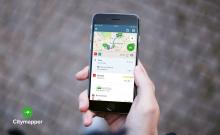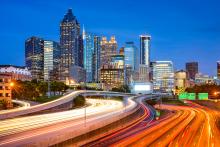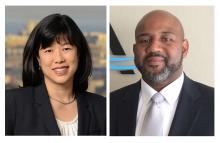Ralf Baron, Thomas Kuruvilla, Morsi Berguiga, Michael Zintel, Joseph Salem and Mario Kerbage from Arthur D. Little explain why there is much to be learned from the Middle East about the rapid evolution of transport systems.
The rapid urbanisation across the globe is leading to mobility challenges as cities struggle to ensure their populations can move around freely using both public and private transport. Solving these issues is critical to ensuring that cities thrive and attract the investment and people they need to grow.
Over the last few decades, the Middle East has witnessed fast population growth, from 186 million people in 1990 to 323 million in 2015 with urbanisation rates increasing from 54% to 63% respectively. Some countries in the region including United Arab Emirates, Saudi Arabia, Kuwait and others, have been in a position to drive major development and growth initiatives that would allow them to become top global economic performers in record time and must now also catch up with urban development issues. With such rapid expansion and urbanisation, they face the full set of urban growth challenges including traffic congestion, transportation safety and security, public transport cost, high usage of private vehicles and environmental considerations.
While the Middle East may have been late to urbanisation, that has provided an enviable opportunity for it to shape its urban mobility strategies and some of its most vibrantly urban centres, such as Dubai, are now building on best practice from around the world. This experience provides lessons, good and bad, for other cities across the globe which are also striving to meet their own mobility challenges.
Transitional or ecosystem
When looking for solutions to address these major transportation challenges government and public authorities in the Middle East have generally followed either the ‘transitional’ or ‘ecosystem’ model.
In the transitional approach, decision-makers initially invest heavily in roads and public transport infrastructure, raising the transportation network’s capacity to absorb the increased demand. This model is inspired by the evolution of transportation networks in the Western world, where it took more than a century to build, develop and maintain advanced public transport networks. Cities in the Middle East tried to follow these models and rapidly strengthened transport modes, often focusing on road and rail networks. Governance is reinforced in parallel through new transport supervision authorities to cover planning, investments and regulation.
While this approach solves immediate issues, it risks not being sustainable enough to address long-term difficulties because addressing congestion solely through infrastructure investments will not solve the long-term problems.
The first reason for this is that with very high (and increasing) growth rates on the demand side, expansion of infrastructure capacity is only a short-term fix. In Dubai, for example, road capacity increased by 36% between 2006 and 2014 during which time the number of cars registered in the country doubled – and that excludes the large inflows of non-Dubai-registered cars entering and exiting the Emirate every day. The city has started to think about new ‘out-of-the-box’ ideas to address the problem differently.
Following the traditional path, albeit much faster, also ignores current trends in urban transportation, particularly around major technological and behavioural changes. Today, it is evident that the private car’s dominance as the main means of transportation is coming to an end. The ‘sharing economy’ means services such as e-hailing, car sharing and the rise of digitally-enabled transport are booming all over the world. Given the Middle East’s young and connected population, this is creating a greater shift in transport habits than in other regions. For example, in Saudi Arabia, half of the population is below 25 and 77% owns a smartphone, driving a sharp increase in e-hailing usage (the local Uber service announced a increase of 50% in the number of trips taken in 2016).
A few advanced cities have taken different paths, the ecosystem model, of reinventing their transportation networks in order to respond to challenges. The key principles of these new approaches are to:
- Develop a holistic view of the mobility model
- Integrate all available mobility modes seamlessly and holistically
- Consider both supply and demand levers to reshape urban transportation
- Effectively leverage innovative, new mobility modes (such as shared or autonomous transport)
Middle Eastern cities provide a favourable environment for this model because there is no heavy legacy transport infrastructure to manage and infrastructure rollouts are faster and easier given the short decision-making process. Furthermore, many of these cities have ambitious transformation plans to increase their attractiveness and an innovative urban transportation experience is seen as a strong differentiator.
At this moment, we can see that the ecosystem approach (usually implemented in a broader smart-city context) is a game changer, leading to progressive urban development opportunities, and that it opens the door to create true impact in a city. This is implemented by incentivising public transport via integrated offerings (and so reducing congestion and carbon emissions), enabling users to seamlessly search, book and pay for integrating mobility and other sectors. Such services see transport modes as complementary rather than competitive and prepare the city to accommodate the future mobility modes.
Lessons learned
Set solid foundations on the supply side: This includes investments in infrastructure and new mobility modes. Dubai is a role model in rapid decision-making, planning and deployment of big infrastructure initiatives with the recently opened Dubai Water Canal, which runs through the heart of the city, taking only three years from the start of the planning to opening.
Set awareness for the necessary shift in mobility demand: Public transport’s share of journeys in Dubai is only 14.4% which is very low compared with other major cities in Asia, Europe and the US (between 35% and 55%). While one explanation might be climate related, the major reason is the mindset of users as, historically, individual transport was the only option. Now Dubai is aiming to move from individual-centred mobility to an integrated system.
Think of mobility as an integrated ecosystem: The establishment and optimisation of single mobility modes and infrastructure components remain important but Dubai understood that the entire system could only be successful if individual modes were networked and integrated in a system that allows users to go from A to B. A trip on the metro from station to station is worthless if the user does not know how to proceed from there, especially in a hot climate with currently underdeveloped walking and cycling options. The solution is to integrate the supply side as well as on the demand side – infrastructure and mobility modes have to be interlinked in order to provide a seamless mobility experience.
Be at the forefront of new mobility technologies: Dubai is continually searching for the latest technologies through innovation labs, international experts, panel discussions, fairs and visiting trips to identify ways to move the mobility system forward. When potentially successful contenders are identified, decision-making and pilot programmes are rapid as Dubai essentially works like a start-up company: if an opportunity is spotted, it is tested.
Conclusion
The dramatic growth of urbanisation is a global trend. It puts tremendous stress on one of the core functions of an urban area – the mobility system. Traditionally, mobility systems have grown up through a “piecemeal” approach. The classical paradigm, a transition model, has gradually added to the supply side of transportation, while different modes were often developed in competition with each other.Today, the transitional approach does not solve the key issues cities are facing and the most effective way forward is an ecosystem approach where mobility is addressed by a truly holistic system where all modes work together. The leaders in applying this type of approach are fast-growing centres such as Dubai which over the last 20 years has raced through the stages of urban development in record time, and is now going beyond the limits of the transition model. Open to new technologies and backed by the means to invest in innovation, these cities are driving the creation and evolution of integrated mobility systems.
Having followed the traditional European and American development path for quite some time, Middle Eastern centres are now setting their own priorities and cities in other parts of the world can learn from their experiences. Urban developers, technology providers and travellers could do well to study how this new ecosystem approach is being applied and in terms of mobility, we may see learning becoming truly bidirectional.










